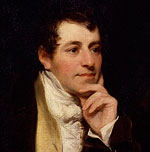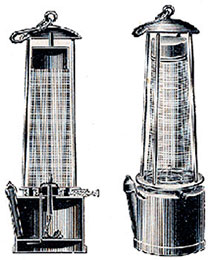Sir Humphrey Davy (1778-1829), born Penzance Cornwall. Chemist and inventor.
Davy was educated in Penzance and Truro. He finished his education under the Rev. Dr. Cardew, who, in a later letter to Davies Gilbert an early mentor to Davy, said dryly: “I could not discern the faculties by which he was afterwards so much distinguished.” Davy said himself: “I consider it fortunate I was left much to myself as a child, and put upon no particular plan of study… What I am I made myself.
He was a keen amateur poet in his formative years and he wrote a number of poems of interest but no particular note. He also took up painting and three of his works are now with Penlee House museum at Penzance.
It was not long though before his interests changed and he took to science as the main focus of his working life, with chemistry playing the leading role. Davy was helped in developing his career by introductions to a number of influential practitioners of different scientific disciplines. This helped accelerate his path to success in a variety of scientific endeavours.
Using a technique, now called electrolysis, he was able to isolate a series of substances for the first time – potassium and sodium in 1807 and calcium, strontium, barium and magnesium the following year. He also studied the forces involved in these separations, thus inventing the new field of electrochemistry. Later on he identified the element iodine for the first time.
Davy’s discoveries of several alkali and alkaline earth metals, as well as contributions to the discoveries of the elemental nature of chlorine and iodine are on record as being major highlights of his life’s work. He has also been credited with, in 1809, inventing the first electric light by connecting a charcoal strip to a battery which made the carbon glow thus producing the first carbon arc light.
However he is popularly best remembered today for his invention of the Davy safety lamp. For many years the coal mining industry had suffered serious underground explosions and fires with inevitable loss of life due to naturally occurring methane gas igniting in the presence of open flames commonly used in mines for lighting. In 1815, he received a letter from some Newcastle miners bringing this to his attention. After some experimentation the resulting ‘Davy lamp’ used wire gauze to prevent the flame spreading and thus significantly reducing the incidence of methane ignition. Other similar designs were produced around the same time, but Davy’s unique wire gauze method proved the most enduring until more modern forms of lighting were invented.
During his distinguished career as a key player in the advancement of scientific discovery he was appointed as President of the Royal Society and he also became a Fellow of the Geological Society. Davy was also a founding fellow of the Zoological Society of London. The Royal Society has awarded the Davy Medal annually since 1877 “for an outstandingly important recent discovery in any branch of chemistry.” He was Knighted in 1812.


